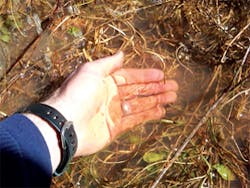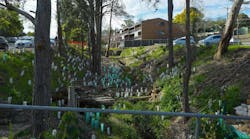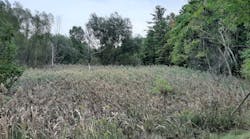Project Profile: Emergency Stormwater Response
In 2010, approximately 35,000 square feet of additions and 80,000 square feet of renovations were made to the existing RC Edwards Middle School located in Central, SC, adjacent to Hartwell Lake off Highway 123 near Clemson University.
Blake Greene of Hanes Geo visited the construction site on a sunny day and asked about the sediment ponds to see if they were achieving the desired nephelometric turbidity unit (NTU) output. The construction site was relatively standard and didn’t appear to have any unusual stormwater runoff concerns. On that particular visit, everything was fine and the contractor saw no need for the StormKlear product that Greene was demonstrating.
However, just days later, the area experienced unusually heavy rains over several days; the sediment ponds overflowed, and stormwater runoff started rushing off the site.
The silt fence in place did its job to help with some of the runoff, but the area was flooded with silty water, and the workers were forced to shut down the site until they could dewater the sediment pond. The contractor now needed help because dewatering highly turbid water was not allowed. The area has a variety of red clay soils, and the contractor remembered that the StormKlear product is designed to work on any soil-unlike soil-specific polyacrylamide (PAM) products. The contractor contacted Greene, who put his “emergency stormwater response kit” into action.
Solving the Problem
“The problem was really twofold,” Greene explains. “First, they needed to dewater the pond so the workers could continue working, and, second, they needed to remain in compliance by removing sediment from the water prior to discharging it offsite.” The contractor was dealing with red clay running down into a culvert that flows in to a local creek; it was obvious to all parties that this was not a good situation. The contractor needed something that would be fast, easy, and cost effective in removing the red sediment from the runoff.
Using a simple manifold system that requires a standard 3-inch trash pump, some PVC pipe, a dewatering bag, and a set of StormKlear Biopolymer socks, Greene was able to help the contractor quickly solve both the dewatering and the water cleaning problems.
The situation was challenging. Under the circumstances, it was better to dewater the pond outside the silt fence barrier. Otherwise, too much water pressure would have been created and would have topped the silt fence, causing all of the trapped, sediment-laden water behind the fence to rush offsite.
“When we set up the system, the influent was registering at 687 NTUs,” says Greene. But after deploying the manifold system in conjunction with the dewatering bag, the discharge was registering at 31.8 NTUs, well within the standard for the county and for state of South Carolina.
By using the StormKlear DPS dewatering manifold system plus the dewatering bag, the contractor was approved to discharge directly offsite, achieving an NTU reading of 31.8. To move the treated water directly offsite, an extra long, 100-foot hose was required.
Setting up the System
Because of the clay soils and volume of rain, turbid water could potentially bypass the standard best management practices (BMPs) that were installed. Therefore, a StormKlear DPS dewatering system using segmented geosynthetic socks was deployed. The socks were installed in a 6-inch, dual-chambered schedule 40 PVC manifold. The DBP-2100 sock was installed in the first chamber and the GelFloc sock in the second; the discharge hose was then routed to a 10-foot-by-15-foot TerraTex N08 filter bag.
A 4-inch schedule 40 PVC was connected to the StormKlear manifold system, which houses the StormKlear socks. The system was then hooked up the 100-foot hose attached to the 3-inch trash pump, which was used to pump the dirty water out of the sediment pond. The 4-inch PVC fits inside the dewatering filter bag. The filter bag comes with a sleeve specifically designed to slide over PVC pipe.
Simple Solution
Every contractor knows it is necessary to dewater, but most of them miss the opportunity to clean the water while they are at it. This can now be a standard best management practice with little incremental expense for the owner. Contractors using this StormKlear DPS dewatering manifold system can keep the system stored onsite at all times as it has a very small footprint. The system consists of a 4-foot-square piece of plywood, a trash pump, about 100 to 200 feet of hose, a dewatering bag, PVC pipe, and a set of StormKlear socks.



